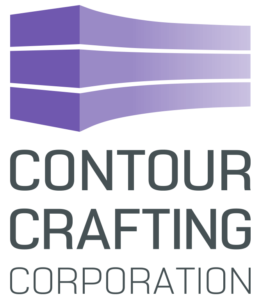One of the very first methods of large-scale 3D printing that the world witnessed was the technology of Contour Crafting Corporation, which uses large but lightweight robotic 3D printers to quickly put down layers of building material in order to rapidly create entire buildings onsite in just days.
Last week, we learned that the US Department of Defense (DoD) had recently awarded California-based Contour Crafting a $3 million research and development contract, effective July 25th, 2018, in the large-scale, construction 3D printing domain. Contour Crafting will use this Rapid Innovation Fund (RIF) to build a concrete 3D printer for the purposes of Rapid Response Construction – quickly constructing buildings for disaster relief, an application that often makes use of 3D printing.
According to the company’s website, “The outcome of this funded R&D program is expected to be a technology which, among other applications, will effectively respond to disaster relief situations with expedient, safe and sustainable structures and buildings.”
The RIF was awarded to Contour Crafting based on its proposal, titled “Autonomous Construction Equipment and Sensing (ACES).” I assume this ACES is not to be mistaken for the US Army’s other ACES program, but as the location on the Federal Business Opportunities page is listed as CERL in Champaign, Illinois, one can’t be too sure.
 Regardless, this contract award to Contour Crafting confirms that the DoD is interested in seeking outside help for its construction 3D printing goals, as opposed to just keeping things in-house…never a bad idea.
Regardless, this contract award to Contour Crafting confirms that the DoD is interested in seeking outside help for its construction 3D printing goals, as opposed to just keeping things in-house…never a bad idea.
Speaking of construction 3D printing goals, Contour Crafting is on a mission to commercialize disruptive construction technologies, and this funding award from the DoD should definitely help the company on its way to achieving it.
In 2015, Dr. Behrokh Khoshnevis, who developed the company’s Contour Crafting technology at the University of Southern California and is its CEO and founder, predicted during an interview with 3DPrint.com that 3D printed homes would be widespread within five years. While the 3D printed housing sector is certainly hard at work, we are definitely not there yet. However, 3D printed construction technology does seem to be the perfect answer for smaller structures, like an army barracks and emergency housing, so it’s smart to focus on these while continuing to build up the technology until it’s ready.
While I did not learn too much more about the company’s newly awarded DoD contract, perhaps due to a non-disclosure agreement or something similar, Dr. Khoshnevis was kind enough to answer some questions for me in regards to Contour Crafting’s construction 3D printing technology, as well as the company’s plans for the future.
How does Contour Crafting’s technology compare to other construction 3D printing?
“CC Corp is currently pursuing both construction and non-construction application domains. The latter has the main advantage of not being subject to regulatory restrictions and the complex and potentially costly process of obtaining approval of regulatory authorities for conformance to building codes, which incidentally is different for different localities because of varying factors such as extent of seismic activities and climatic conditions.
“In the field of construction we are advancing more cautiously as we are exploring potential implementation problems and solutions. We are doing many experimentations in-house and are preparing for some field tests as well.
“We have maintained our interest in the field of planetary construction as our prior accomplishments in the field, which include two NASA international competition Grand Prizes, have been noteworthy. We are developing new technologies for in-situ material usage for construction of a variety of useful infrastructure elements such as landing pads, blast protection walls, shade walls, radiation shielding walls, hangars, and roads.”
Discuss this story and other 3D printing topics at 3DPrintBoard.com or share your thoughts in the Facebook comments below.
Subscribe to Our Email Newsletter
Stay up-to-date on all the latest news from the 3D printing industry and receive information and offers from third party vendors.
You May Also Like
Why Corrosive Resistant Materials Are Important to the Success of 3D Printing Across Industries
The adoption of additive manufacturing (AM) is accelerating across many major industries. As this technological shift unfolds, the importance of corrosion resistance has emerged as a challenge for 3D printing...
America Makes Announces IMPACT 2.0: $6.6M in New 3D Printing Funding
America Makes, the Manufacturing Innovation Institute (MII) based in Youngstown, Ohio, has announced IMPACT (Improvement in Manufacturing Productivity via Additive Capabilities and Techno-Economic Analysis) 2.0, a project call which will...
3D Printing Webinar and Event Roundup: April 14, 2024
We’re starting off the week’s 3D printing webinars and events at ASTM AMCOE’s 11th Snapshot Workshop and MACH Exhibition. Stratasys continues its advanced training courses, SME is holding a virtual...
AMUK Welcomes Airframe Designs as British 3D Printing Industry Grows
While the UK is not the hub for 3D printer and materials manufacturers as other nations, the country continues to excel at the research, development, and application of additive manufacturing...


































